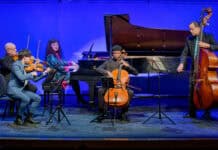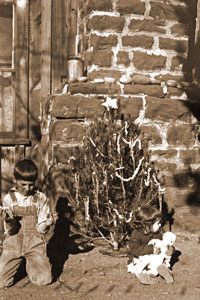Some people are still around to remember Sedona’s early days, long before its incorporation and long before waves of tourists threatened to outnumber its inhabitants — a time when families farmed the land to survive and always got together on Christmas Eve.
Larson Newspapers
Some people are still around to remember Sedona’s early days, long before its incorporation and long before waves of tourists threatened to outnumber its inhabitants — a time when families farmed the land to survive and always got together on Christmas Eve.
Christmas Eve was a day of celebration, particularly at Sedona School, where children entertained their parents, there was music and everyone danced.
According to Mary Wyatt, who grew up in Sedona, there were always stockings packed with hard candy, an orange and sometimes a small toy for the children.
The stockings were usually gifts from Ed Black and Frank Jackson who ran L.E. “Dad” Hart’s general store near the ‘Y’ Intersection.
Only about 40 children attended Sedona School when Wyatt arrived in 1939, she said, but with the stockings, even those children who didn’t have much at least got something for Christmas.
Under a 14-foot spruce tree, which students and teachers decorated, teachers handed out presents to their pupils, according to Forest Ranger Fred Croxen, who wrote about the celebrations in an article published in the Sedona Westerners book “Those Early Days.”
Teacher Edith Lambert Croxen remembered the annual Christmas plays and recitations in her essay for “Those Early Days.”
“I recall with a great deal of pleasure how hard they worked and how proud their parents were of them,” Croxen wrote.
A local father always dressed up as Santa and Croxen usually gave her students books, she said.
There were fiddlers and accordion players and everyone had a good time, she said.
“The program, dance and lunch were enjoyed by all who were there,” Croxen wrote.
For many people, the party was the first time they’d seen each other since the previous spring, according to Wyatt.
Most cattlers left the area for the summer to raise livestock on government land in the mountains during the summer.
Since ranchers were paid only once a year, they were able to settle debts with the local general store during the holidays and there was always a lot of catching up at the party.
Thanksgiving was more of a family day, Wyatt said, but Christmas was a celebration. People danced, ate and socialized, and everybody knew everybody.
“It was a party,” Wyatt said.
Major Sherman Loy, who grew up in Red Rock, also attended Sedona School. He agreed that the school celebration was a big event for the community and said he even played a few songs on the piano one year, an ability he soon forgot, he said.
On Christmas morning, Loy and his family usually gathered at his grandmother’s house.
A family friend who owned a drug store in Prescott always sent great gifts, including dolls for his younger sister Martha Loy and a wind-up train for him in 1931 when he was 5 years old, he said.
When Wyatt returned home after the Sedona School Christmas party, she said she always placed milk or cocoa and a few gingerbread cookies on a table near the Christmas tree before going to bed.
Her father always took a bite of a cookie and a sip of the milk while placing presents under the tree, Wyatt said, and at that time, most of the gifts were homemade — a detail that seems particularly worth remembering in light of today’s commercialization of the holiday.
“To me, the homemade gifts had a lot more love in them than just running to the store to buy something,” Wyatt said.
Of course, many of the traditions once typical of Christmas have faded over time.
For some people, the religious implications of a time once set aside to observe the Winter Solstice seem out of tune with their own intuitions.
For others, the day is one they’ll always use to demonstrate their faith.
But for others still, none of that really seems to matter. It’s a time to be with friends and family, to give and to receive — to celebrate life and at least part of what it means to be human.
Tyler Midkiff may be reached at 282-7795, Ext. 122, or e-mail to tmidkiff@larsonnewspapers.com




















